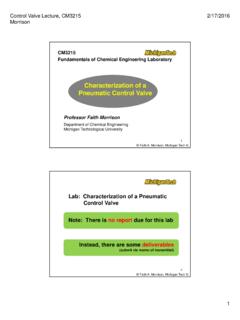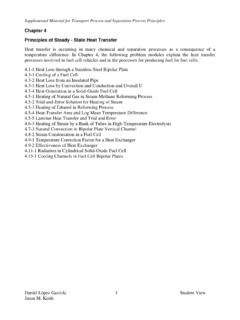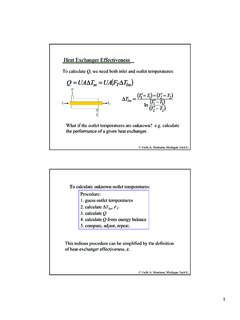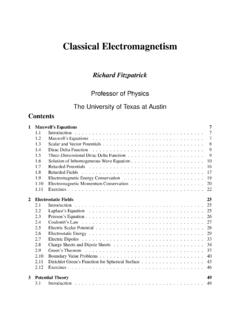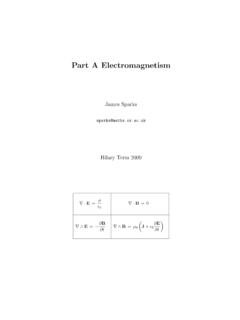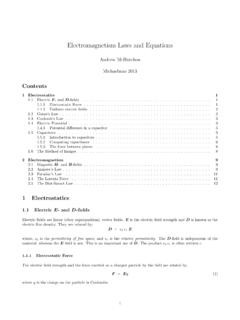Transcription of Introduction to Electromagnetic Theory
1 1/19/181 Lecture topics Laws of magnetism and electricity Meaning of Maxwell s equations Solution of Maxwell s equationsIntroduction to Electromagnetic TheoryElectromagnetic radiation: wave model James Clerk Maxwell (1831-1879) Scottish mathematician and physicist Wave model of EM energy Unified existing laws of electricity and magnetism (Newton, Faraday, Kelvin, Amp re) Oscillating electric field produces a magnetic field (and vice versa) propagates an EM wave Can be described by 4 differential equations Derived speed of EM wave in a vacuum Speed of light measured by Fizeauand Foucault between 1849 and 18621/19/182 Electromagnetic radiation EM wave is: Electric field (E) perpendicular to magnetic field (M) Travels at velocity, c(~3 108m s-1, in a vacuum)Dot (scalar) productA B= |A||B| cos If Ais perpendicular to B, the dot product of Aand Bis zero1/19/183 Cross (vector) productaxb=[(a2b3-a3b2), (a3b1-a1b3), (a1b2-a2b1)]a b= |a||b| sin nIfaisparallel tob, the cross product ofaandbis zeroDiv, Grad, CurlTypes of 3D vector derivatives:The Deloperator: The Gradientof a scalar function f(vector):The gradient points in the direction of steepest ascent.
2 X, y, z$%&'() f f x, f y, f z$%&'()1/19/184 Div, Grad, Curl The Divergenceof a vector function (scalar):yxzffffxyz ++ rrThe Divergenceis nonzero if there are sources or 2D source with a large divergence:xy f= fx x+ fy y+ fz zDiv, Grad, CurlThe Curl of a vector function f: f fz y fydz, fx z fzdx, fy x fxdy&'(()*++Functions that tend to curl aroundhave large , Grad, CurlThe Laplacianof a scalar function :The Laplacian of a vector function is the same, but for each component of f: 2f f= f x, f y, f z%&'()*222222fffxyz =++ 2 f= 2fx x2+ 2fx y2+ 2fx z2, 2fy x2+ 2fy y2+ 2fy z2, 2fz x2+ 2fz y2+ 2fz z2#$%%&'((The Laplacian tells us the curvature of a vector s Equations Four equations relating electric (E) and magnetic fields (B) vector fields 0is electric permittivity of free space (or vacuum permittivity -a constant) resistance to formation of an electric field in a vacuum 0= 10-12 Farad m-1 0is magnetic permeability of free space (or magnetic constant -a constant) ability of a vacuum to support formation of a magnetic field 0 = 10-6T m A-1(T = Tesla.))))
3 SI derived unit of magnetic field) E= 0tBE = 0= BtEJB += 000 Note: is divergence operator and is curl operator1/19/186 Biot-Savart Law (1820) Jean-BaptisteBiotand Felix Savart(French physicist and chemist) The magnetic field B at a point a distance Rfrom an infinitely long wire carrying current Ihas magnitude: Where 0is the magnetic permeability of free space or the magnetic constant Constant of proportionality linking magnetic field and distance from a current Magnetic field strength decreases with distance from the wire 0 = m A-1(T = Tesla; SI derived unit of magnetic field) B= 0I2 RCoulomb s Law (1783) Charles Augustinde Coulomb (French physicist) The magnitude of the electrostatic force (F) between two point electric charges (q1, q2) is given by: Where 0is the electric permittivity or electric constant Like charges repel, opposite charges attract 0= 10-12 Farad m-1 F=q1q24 0r21/19/187 Maxwell s Equations (1) Gauss law for electricity: the electric flux out of any closed surface is proportional to the total charge enclosed within the surface; a charge will radiate a measurable field of influence around it.
4 E= electric field, = net charge inside, 0=vacuum permittivity (constant) Recall: divergence of a vector field is a measure of its tendency to converge on or repel from a point. Direction of an electric field is the direction of the force it would exert on a positive charge placed in the field If a region of space has more electrons than protons, the total charge is negative, and the direction of the electric field is negative (inwards), and vice versa. E= 0 Maxwell s Equations (2) Gauss law for magnetism: the net magnetic flux out of any closed surface is zero ( magnetic monopoles do not exist) B= magnetic field; magnetic flux = BA (A = area perpendicular to field B) Recall: divergence of a vector field is a measure of its tendency to converge on or repel from a point. Magnetic sources are dipole sources and magnetic field lines are loops we cannot isolate N or S monopoles (unlike electric sources or point charges protons, electrons) Magnetic monopoles couldtheoretically exist, but have never been observed0= B1/19/188 Maxwell s Equations (3) Faraday s Law of Induction: thecurl of the electric field(E) is equal to the negative of rate of change of the magnetic flux through the area enclosed by the loop E= electric field; B= magnetic field Recall: curl of a vector field is a vector with magnitude equal to the maximum circulation at each point and oriented perpendicularly to this plane of circulation for each point.
5 Magnetic field weakens curl of electric field is positive and vice versa Hence changing magnetic fields affect the curl ( circulation ) of the electric field basis of electric generators (moving magnet induces current in a conducting loop) tBE = Maxwell s Equations (4) Amp re sLaw: thecurl of the magnetic field(B) is proportional to the electric current flowing through the loop B= 0J + 0 0 E tAND to the rate of change of the electric field. added by Maxwell B= magnetic field; J = current density (current per unit area); E= electric field The curl of a magnetic field is basically a measure of its strength First term on RHS: in the presence of an electric current (J), there is always a magnetic field around it; Bis dependent on J ( , electromagnets) Second term on RHS: a changing electric field generates a magnetic field. Therefore, generation of a magnetic field does not require electric current, only a changing electric field.
6 An oscillating electric field produces a variable magnetic field (as E/ tchanges)1/19/189 Putting it all An oscillating electric field produces a variable magnetic field. A changing magnetic field produces an electric so on. In free space (vacuum) we can assume current density (J) and charge ( ) are zero there are no electric currents or charges Equations become: E=0tBE = 0= B B= 0 0 E tSolving Maxwell s EquationsTake curl of:Change the order of differentiation on the RHS: E= B t [ E]= [ B t] [ E]= t[ B]1/19/1810 Solving Maxwell s Equations (cont d)But (Equation 4): Substituting for , we have:Or: [ E]= t[ E t] [ E]= 2 E t2 [ E]= t[ B] assuming that and are constant in time. B= E t BSolving Maxwell s Equations (cont d)Using the identity, becomes: Assuming zero charge density (free space.)
7 Equation 1):and we re left with: [ E]= 2 E t2 ( E) 2 E= 2 E t2 E=0 2 E= 2 E t2 Identity: [ f] ( f) 2 f1/19/1811 Solving Maxwell s Equations (cont d)The same result is obtained for the magnetic field are forms of the 3D wave equation, describing the propagation of a sinusoidal wave:Where v is a constant equal to the propagation speed of the waveSo for EM waves, v = 2 E= 2 E t2 2u=1v2 2u t2 2 B = 2 B t2 1 Solving Maxwell s Equations (cont d)So for EM waves, v= , Units of = Tesla (T) can be written as kg A-1s-2So units of are kg mA-2s-2 Units of = Farad m-1or A2s4kg-1m-3in SI base unitsSo units of are m-2s2 Square root is m-1s, reciprocal is ms-1 ( , velocity) 0= 10-12and 0= 10-6 Evaluating the expression gives 108ms-1 Maxwell (1865) recognized this as the (known) speed of light confirming that light was in fact an EM wave.
8 1 1/19 , from the Sun to the vinyl seat cover in your parked energy flow of an Electromagnetic wave is described by the Poyntingvector:EM waves carry energy how much?The intensity (I) of a time-harmonic Electromagnetic wave whose electric field amplitude is E0, measured normal to the direction of propagation, is the average over one complete cycle of the wave:WATTS/ M2 Key point: intensity is proportional to the squareof the amplitude of the EM waveNB. Intensity = Flux density (F) = Irradiance (incident)= Radiant Exitance(emerging)P = Power; A = Area; c= speed of lightSummary Maxwell unified existing laws of electricity and magnetism Revealed self-sustaining properties of magnetic and electric fields Solution of Maxwell s equations is the three-dimensional wave equation for a wave traveling at the speed of light Proved that light is an Electromagnetic wave EM waves carry energy through empty space and all remote sensing techniques exploit the modulation of this energy1/19/1813 Summary EM wave propagation.
